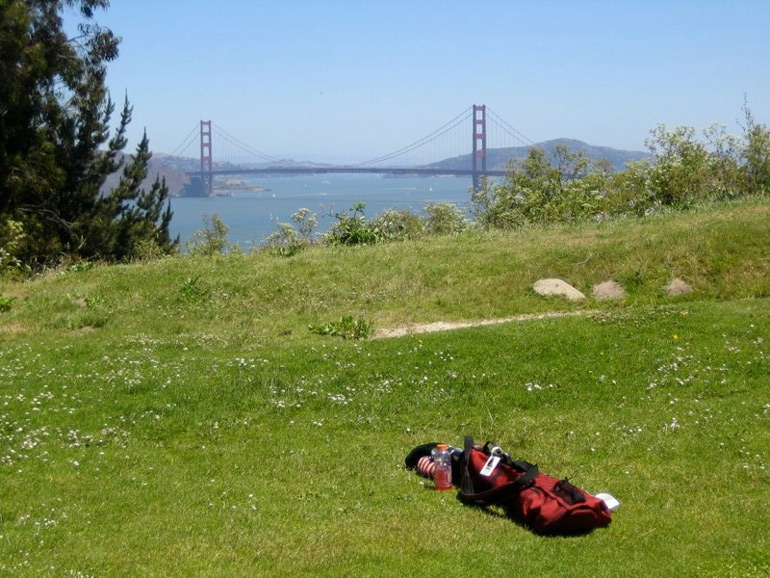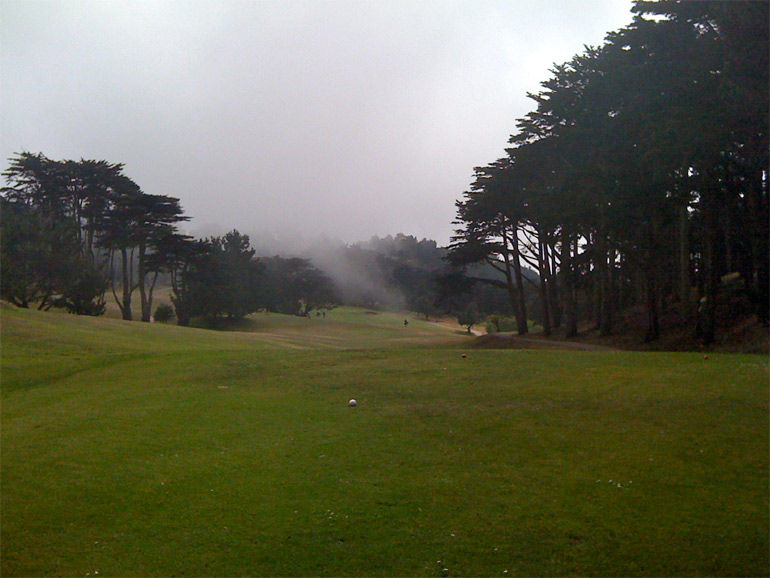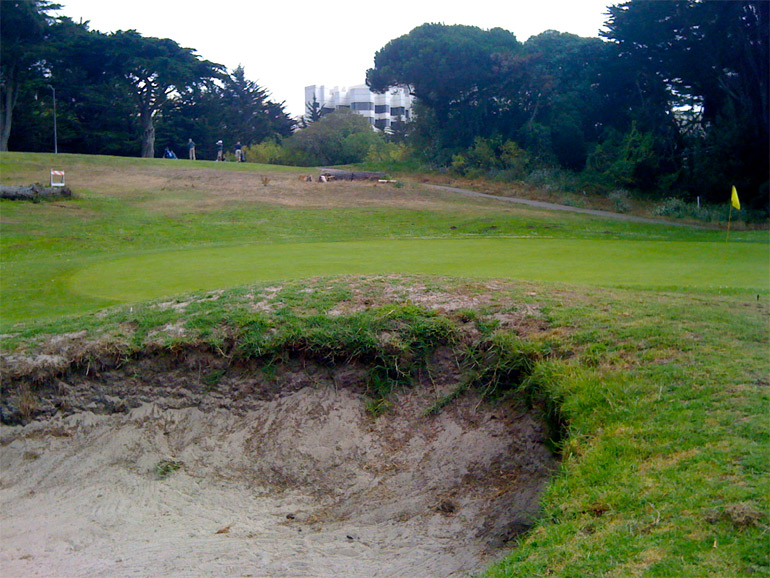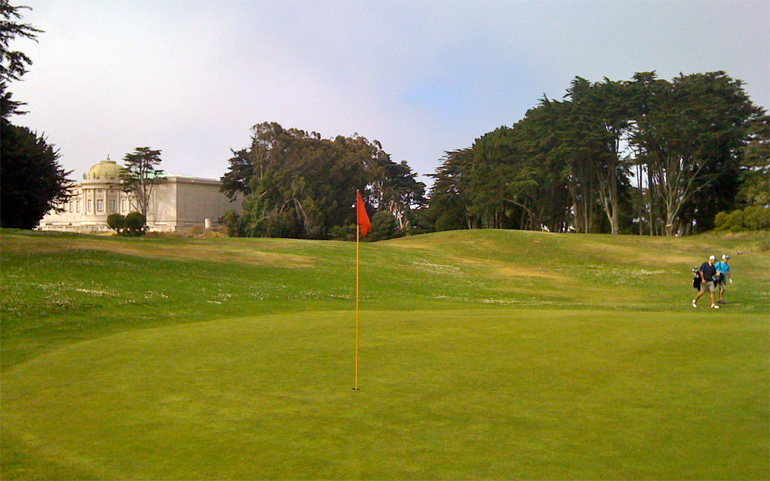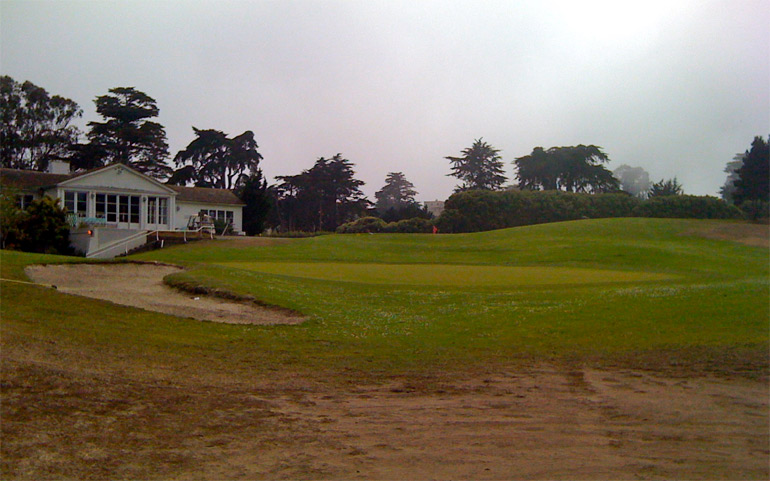Lincoln Park Golf Course in San Francisco
Matt Cohn
February 2013
I’ve heard some good ones about the conditions at Lincoln Park. One joke is that, “At Lincoln Park, there are certain fairways that simply must be avoided.” Another line claims, “Lincoln Park is so wet in the winter that when they turn on the sprinklers, it actually gets drier.” The reality is that this is what most serious golfers think of when asked their opinion of Lincoln Park. Yet there is so much more to the golf course and its history.
Golf has been played since 1902 in the far northwest corner of San Francisco, where the Pacific Ocean makes its way into the Golden Gate. The golf course is situated in quite an incredible spot, high on a hill overlooking the City, the Pacific, and a series dramatic cliffs and bluffs that plunge their way down to the rocky shore.
Like its cousin Sharp Park, Lincoln Park’s future is not entirely assured. Recently Lincoln Park was the subject of a proposal to replace the current eighteen hole course with soccer fields, an event center, and an amphitheater, along with a weirdly sited driving range and a nine-hole par-3 course. That threat, like the threat to Sharp Park, appears to have passed for now thanks particularly to the hard work of the San Francisco Public Golf Alliance. Still, continuing vigilance will be required.
For the purposes of this website, I hardly need to make the case for why it’s worth saving public golf in big cities. What I hope to focus on here is how good of a golf course Lincoln Park…well, how good it could be. Much of what’s architecturally great about Lincoln Park is hidden behind overgrown trees, covered up by daisies and long grass in the fairways – hell, daisies and long grass on the greens if you catch it on the right day! – and bunkers that you’d swear were from a long-abandoned course. One of the most maddening elements of the Lincoln Park situation is that the course wouldn’t be underutilized and underprofitable if only it were maintained. Instead the course is allowed to sink further and further into disrepair – potentially sealing its fate as a “bad use of land”.
My favorite story of maintenance at Lincoln Park is from the day when I saw a neatly mown footpath leading off the 6th tee, only to stop after 70 yards because there was no fairway.
Yes, it’s a mess, and no, it wasn’t always that way. But under that mess is the structure of a wonderful and unique golf course – one that, at only 5,146 yards and par 68, still provides a wonderfully varied and strategic challenge. The combination of the terrain, setting, quirk, conditions, and unusual yardages – ten par-4’s under 350 yards? Seven holes in the 200’s on the back nine? – produces a golf course that is both exceptional and totally unusual. Beyond all that Lincoln represents to the city, its architecture alone makes it worth the fight to save it.
Perhaps two themes emerge in a tour of the course: first, how many holes use the terrain (rather than sand or water) to create interesting strategy; and second, how much of that interest and strategy is compromised by the soft and slow conditions. By the way, don’t be fooled by the brown throughout the course – although it looks dry, the course plays soft and slow year-round. I’ve tried to select photos below that show not only the architecture of the course, but also the beauty of the setting and the sad state of the current maintenance practices.
Hole 1, 314 yards, par-4: A neat strategic hole; a draw played near the OB line leaves a clear shot to the green, while a shot hit weakly to the right leaves an uphill approach over a series of tall trees. The crowned green is not too scary, as the surrounds are too soft and slow for the ball to be repelled a significant distance from the surface.

The uphill first hole, with the tee just to the right of the cart path in the distance. The ideal tee shot finishes closer to the right edge of this picture rather than on a straight line from tee to hole.
Hole 2, 257 yards, par-4: The first of the tricky, drivable par-4’s. Trees block a direct route to the green, necessitating a left-to-right shot. However, a driver that doesn’t fade might end up lost or unplayable in the bush or high grass left of the green.

The drivable second hole, with the flag barely visible under the branches of the first tree on the right.
Hole 3, 156 yards, par-3: The dogleg left, par-3 third hole features a forest left and OB a few paces right of the green. Good hole? Bad hole? Depends how you view dogleg par-3’s, but it won’t remind you of many holes you’ve played before.
Hole 4, 321 yards, par-4: The hole plays into the wind, and a deep swale cuts through the fairway in the driving zone. A layup from the tee leaves an 8- or 9-iron; a bolder shot finishes in the swale, leaving an impeded view of the flagstick; and a driver has to deal with trees left and the ground sloping right towards a hazard.
Hole 5, 359 yards, par-4: An appealing tee shot, played downwind to a huge, rumpling fairway whose right side is 15 feet higher than its left. A pedestrian tee shot down the left side leaves a steeply uphill approach shot over sand to a shallow green. A thoughtful tee shot near the bushes and trees on the higher right side leaves a better angle and potentially a view of the green surface. Again, soft conditions have moderated the value of such strategic play.

From behind the green, the cant of the 5th fairway is apparent. One can imagine how a downwind shot from the low left side of the fairway would be a great challenge – if the green were firm.
Hole 6, 283 yards, par-4: The hole tees off against the back wall of the Palace of Fine Arts, the spectacular museum in the center of Lincoln Park Golf Course. In its current form the hole is slightly silly because trees near the tee force any shot longer than 200 yards to be played significantly left-to-right. Again though, there is an interesting strategic decision: a layup from the tee often leaves a partial view of the green and an awkward lie on a large mound, while a driver or 3-wood must be shaped into an uncomfortable landing area that is blind from the tee.

…but the tee shot itself is a bit strange. The green is in line with the big tree trunk on the right. No joke!
Hole 7, 334 yards, par-4: A blind tee shot up and over a saddle, then down a steep hill (and downwind) to the green. With fast and firm conditions, almost any tee shot would reach the front of the green, and the hole might benefit from an addition bunker or other form of defense. As it is now, the second shot – often 40-70 yards from a slight downhill lie – is difficult.
Hole 8, 170 yards, par-3: Probably the most tired-looking hole on the course, with a small round green and gigantic built up lips on the bunkers. Nice view, though.
Hole 9, 309 yards, par-4: Straight uphill, this hole necessitates an accurate tee shot and presents another layup-vs.-driver decision. A layup often finishes on the steepest part of the uphill slope; a driver missed left or right could find trouble.

The 8th green in the foreground, 7th fairway upper-middle, and 9th fairway going uphill towards the trees top-right.
Hole 10, 268 yards, par-4: The first of seven holes on the back nine between 200 and 299 yards. Trees require another left-to-right tee shot if the player chooses a driver, and a miss either way leaves an awkward pitch. Anything short of the green requires a partially blind second shot up a steep rise to a green set at the base of the museum.
Hole 11, 265 yards, par-4: To me, perhaps the best hole on the course. The hole arcs left around trees and an embankment. In front of the green, a huge mound makes many approach shots blind while also complicating efforts to reach the green from the tee. The hole might be improved by removing a few trees down the left side, creating a more tempting view of the green. On the other hand, the requirement to play a draw that could bounce anywhere off the big mound probably makes for a more interesting hole.

The huge mound in front of the 11th green can kick balls in any direction; it tends to accentuate whatever the golf ball is already doing, for better or worse. Anything left of this picture is big trouble.

From behind the green, note the size of the 11th hole’s mound relative to the size of the golfers on and to the left of it.
Hole 12, 203 yards, par-3: The first of three really hard par-3’s on the back nine. This one is played uphill and into the wind. There’s no sand, but the opening in the trees is narrow and there’s virtually no way to run the ball up to the green.
Hole 13, 500 yards, par-5: One of the few holes where the player feels free to blast away, as this appealing tee shot is downhill, downwind, and over a couple of gigantic “field goal” cypress trees. But this feeling is false: in fact, a huge downslope in the fairway makes length a non-issue. The real concerns are the huge trees left of the fairway and a, uh, “monumental” obstacle to the right. One of the few relevant bunkers on the course is placed 20 yards short-right of the green, the perfect place to catch a long second shot played from a downhill lie in the fairway.

A pushed tee shot faces interference not only from trees, but also from this old monument just a few steps off the fairway.

From behind the green, one can see the steep downslope in the 13th fairway. The maintenance practices mean that good tee shots tend to stop on the downslope rather than rolling to the bottom.
Hole 14, 259 yards, par-4: A potentially challenging hole, but not really one of the better ones on the course. The tee shot is a forced layup into the side of a hill, followed by a semi-blind wedge to a plain green.

The dogleg left on the 14th hole is too sharp and narrow to reasonably go anywhere but straight ahead.
Hole 15, 282 yards, par-4: A layup is wise on this hole as the fairway narrows near the green. The greensite is attractive, but not the most complex one. The main challenge of this hole comes from the second shot, which is generally played from a sidehill lie and into the wind.
Hole 16, 239 yards, par-3: The green on this long par-3 is a surprisingly difficult target: small, two-tiered, with little run-up opportunity and a deep bunker on the left.
Hole 17, 240 yards, par-3: Lincoln Park’s most famous hole, known for its cliffside setting and spectacular views of the Golden Gate Bridge on clear days. The hole itself is a long downhill par 3 that plays the same length as the previous hole, though this time with an opening at the front of the green.

…and a few years ago on a sunny day. The other way to tell that this picture is more than 5 years old? Mower stripes.
Hole 18, 383 yards, par-4: The most “normal” par-4 on the course, the 18th hole plays straight towards the weathered white clubhouse. The terrain is again the main feature here: the fairway is semi-blind from the tee, and the green is semi- to fully-blind depending on one’s position from the tee. The green itself sits in a three-quarter punchbowl, but again the soft and slow turf makes it impossible to use this punchbowl to any effect.
The question of what Lincoln Park would be like with firm turf and a little TLC is probably nothing more than a hypothetical. For fans of golf course architecture though, and of the ground game in particular, it’s a fun question to ponder. Golfers would face decisions and complexity on every shot: just to name a few, a suddenly dangerous crowned first green, a testing approach uphill to the fifth to the shallow green, balls galloping wildly down the hill on the seventh and bouncing in all directions off the big mound on the twelfth…the list goes on.
For San Francisco’s golfers, these are hopefully questions to be pondered in the future. For now, the only item on the agenda is to ensure the continued existence of the golf course itself, as the loss of Lincoln Park Golf Course would be the ultimate disgrace to a fascinating course that has been allowed to deteriorate much too far already.
Given that an order-of-magnitude improvement in the conditions at Lincoln Park seems almost impossibly unlikely, perhaps the best we can do is to accept it as is, acknowledge what could have been, and appreciate that we have this golf course at all.
THE END




